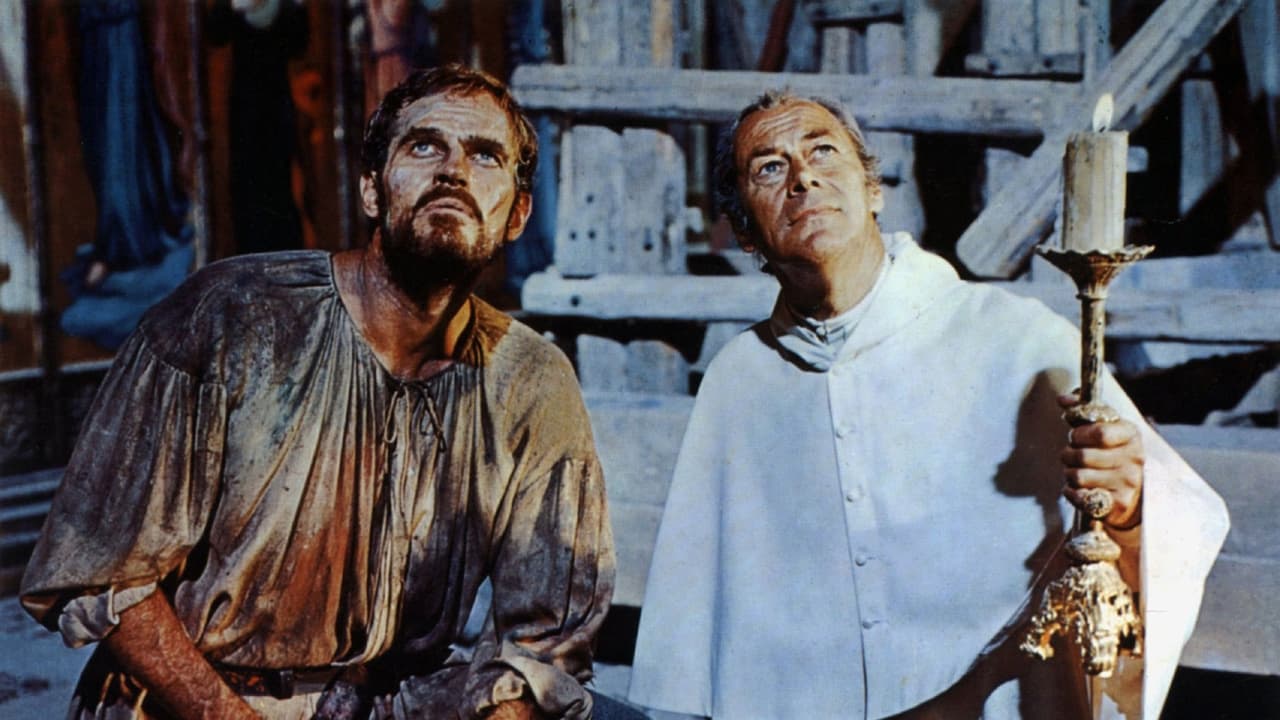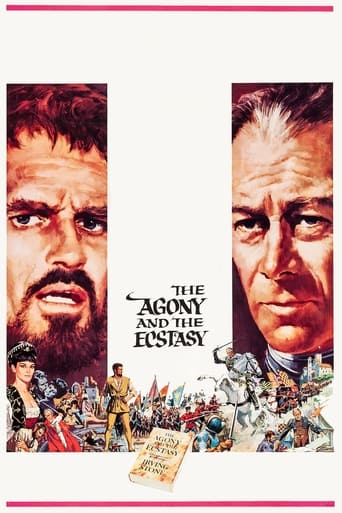

Not quite the disaster the critics made it out to be but hardly likely to be remembered among the best of Carol Reed. It was a prestige production done on a grand scale but neither Philip Dunne's screenplay nor, indeed, Irving Stone's original novel were inspirational. The subject, of course, is Michaelangelo's painting of the ceiling of the Sistine Chapel and Charlton Heston, who else, is a hugely miscast Michaelangelo, (he's heterosexual, for starters). He does what he can with the part but the material defeats him. On the other hand, Rex Harrison not only carries the movie but redeems it. He barnstorms his way through the part of Pope Julius II, the man who commissioned Michaelangelo in the first place. He even manages the fanciful dialogue, barking it out as though it were Shakespeare. There's also a decent supporting cast, both British and Italian, with the Italians largely dubbed, but they too are wasted. Does it give us any insight into the man or his work? Absolutely not, but as epics go it's a pleasant enough time-passer.
... View MoreA provocative tale of two of arguably the most influential figures during the renaissance – a famed sculptor whose reputation may have gone to his head, and a stalwart strong-willed decisive pope who not only was responsible for the spiritual lives of the citizenry, but for the sovereignty of the country.The two figures inevitably clash when the pragmatic cost-conscious Pope Julius II forces the hand of the artist (pardon the pun) to paint the ceiling of the Sistine chapel – a task that Michelangelo feels ill-suited of his great talent as a sculptor.And clash they most certainly do. For most of the film, each time they are together, we see them engaged in head butting. Their numerous disputes range from light moments of disgusted condescension to dramatic disrespectful outbursts. If we didn't already know of the existence of the masterpiece, we ourselves would wonder whether it would ever be completed.And yet, in the end, the dictatorial authority of one and the uncontrolled insolence of the other move both characters to achieve their goals. The rarity of their reflective discussions together only serve to amplify the depth of respect they have for one another, culminating in what I consider one of the most beautiful scenes in the movie where they discuss the images of God and Adam, to which the pope acclaims, "If I had to choose my life over again, I think I would choose to be an artist."Finally, they acknowledge that they both were instruments used by God to create such a masterful proof of faith that has stood the test of time.We are drawn to love and appreciate both characters, which the author masterfully develops to a point where they are transformed. But it isn't so much that their personalities change, but more so their outlook towards one another that undergoes a gradual transformation.
... View MoreThe Agony and the Ecstasy (1965)Coming with the American rush to "love art" in the 1950s and 60s (including the famous visit of the real Mona Lisa to America by boat), "The Agony and the Ecstasy" is a touchstone of how to make a hero of an artist and make him or her human, too. That's the key, you know--the artist has to be ribald and earthy but also transcendent, almost beyond his knowing.That's the flawed paradigm at work here. We learn nothing about how Michelangelo's art was made--how it was painted. Nor how it was devised or inspired--the image of God in the clouds doesn't cut it for me. And we actually learn nothing about the real man--Charlton Heston's interpretation is fair enough, I suppose, but it's really just the necessary cliché of a talented (handsome) man tossed around by forced bigger than him.What is supposed to drive the movie, and in a way saves it as a piece of entertainment, is the presence of the penny-pinching Pope, played by Rex Harrison (of "My Fair Lady" and "Julius Caesar" fame). His haranguing about the ceiling is blithe and fun. And Heston's complaining as he creates his masterpiece (with plaster dripping on his face--actually pudding in the shoot) is a foil for the Pope more than anything. Oddly, the Pope is a stronger character than the artist, and if history is at all right, we get the sense it was the other way around.What is terrific about the movie is the set--a replica of the Sistine Chapel in a nearby movie studio. They gave them freedom to shoot it in all different phases of the painting, with and without scaffolding, night and day, and it's pretty marvelous to see it unfold in a way not so far from what must have been the truth.Another bit of truth snuck in during these last days of the Hays Code: when someone comes looking for Michelangelo in the whore house, the prostitute goes hysterical laughing because, of course, he would never be found there. The artist was gay, and the world knew it then and knows it now, and the filmmakers get a clever wink in.Another highlight is the incredible marble quarry in Carrara, a real place with what really is the best (seamless, pure, easily sculpted) marble in the world. Lucky it was nearby ancient and Renaissance Rome, both.Don't avoid this movie at all, but don't expect anything truly penetrating. It's aggrandizing, it's formulaic, it's well filmed, and Harrison is in great form. But director Carol Reed ("The Third Man") chickened out a bit in a chance to push the boundaries a little harder.
... View MoreOkay, okay, it's not that bad, I just had to use that joke... Then again, it's a close thing in the early days. It begins with a 10-minute rushed bio of Michelangelo narrated by an American who's no Kenneth Clark... it sounds like those awful Disney documentaries. Lots of shots of Michelangelo's sculpture and so on...Then the movie gets underway and it's Heston as the artist and Harrison as the Pope. Except they always play the same types mostly, so it sort of lacks credibility. Harry Andrews wasted in a support role. Adolfo Celi, who played Largo in Thunderball one year earlier, is dubbed (badly) into American. Diane Cilento, Sean Connery's then-wife, is a not very attractive harpy type, a kind of love interest/shoulder to cry on. During one awful moment she bucks up the distraught artist, saying, "And get that ceiling finished!" sounding for all the world like some nagging housewife. "And then you're to fix the garden gate and call round my mother-in-law's!" It gets better as it goes on, after the interval. And it's good to see Harrison playing a more devout type, rather a rascally self-centred rogue. But much of it seems to be about conflict and argument for the sake of it, to create a drama of some kind.
... View More